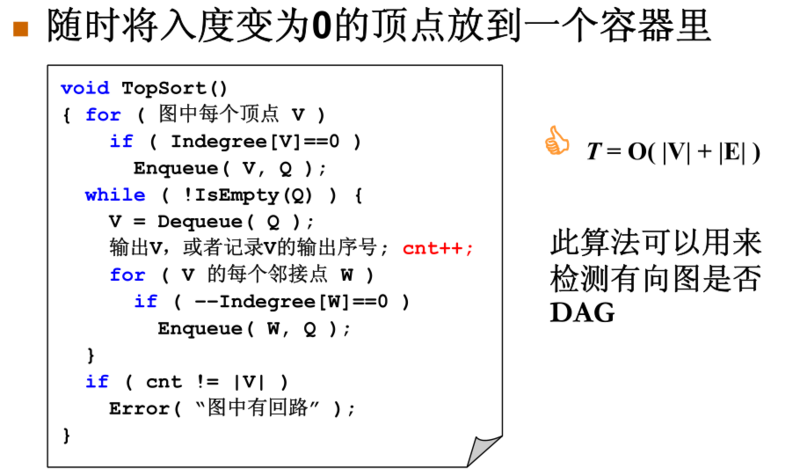比较好的一个算法

DAG : 有向无环图。
xmuOJ 选课
一个点的入点(指向它的点怎么表示)怎么表示? 数组 or vector?
我最后选择了邻接矩阵。
#include <iostream>
#include<stdlib.h>
#include <vector>
#include<stdio.h>
#include<string>
#include<queue>
#include<string.h>
using namespace std;
typedef queue<int> Q;
int main()
{
int N;
string name[501];
int a[501][501]; //a[i][j] = 1 则 i指向j
int rudu[501];
Q topQ;//top dui lie
Q zeroQ;
int i,j,k;
//initialize
memset(a, 0, sizeof(a));
scanf("%d", &N);
for (i = 1; i <= N; i++)
cin >> name[i];
for (i = 1; i <= N; i++)
{
scanf("%d", rudu + i);
if (rudu[i] == 0)
zeroQ.push(i);
for ( j = 1; j <= rudu[i]; j++)
{
int b ;
scanf("%d", &b);
a[b][i] = 1;
}
}
int top[501], cnt = 0;
while (!zeroQ.empty())
{
top[++cnt] = zeroQ.front(), zeroQ.pop();//
for ( i = 1; i <= N; i++)
{
if (a[top[cnt]][i] == 1)
{
if (--rudu[i] == 0)
{
zeroQ.push(i);
}
}
}
}
if (cnt!= N)
{
printf("Impossible!");
return 0;
}
for (i = 1; i < N; i++)
{
cout << name[top[i]];
printf(" ");
}
cout << name[top[N]];
return 0;
}
/*
9
Introduction_to_Computer_Science C_Programming_Language Data_Structure Design_and_Analysis_of_Algorithms Mathematical_Analysis Advanced_Algebra Probability_and_Statistics Numerical_Analysis Operating_System
0
1 1
2 1 2
3 1 2 3
0
0
1 5
2 5 6
2 1 2
*/



 本文介绍了一种使用有向无环图(DAG)解决xmuOJ在线选课系统的课程依赖问题的方法。通过邻接矩阵记录课程间的依赖关系,并采用拓扑排序算法来确定合理的选课顺序。
本文介绍了一种使用有向无环图(DAG)解决xmuOJ在线选课系统的课程依赖问题的方法。通过邻接矩阵记录课程间的依赖关系,并采用拓扑排序算法来确定合理的选课顺序。
















 3238
3238

 被折叠的 条评论
为什么被折叠?
被折叠的 条评论
为什么被折叠?








